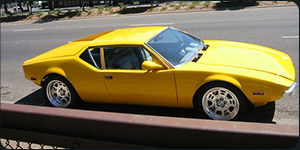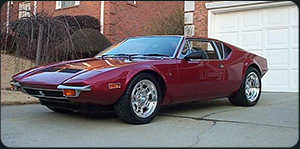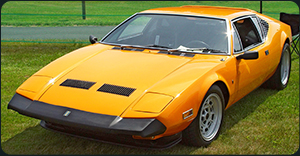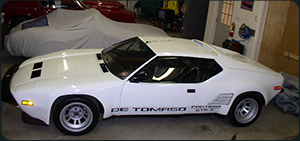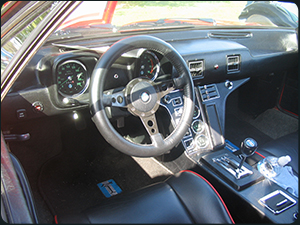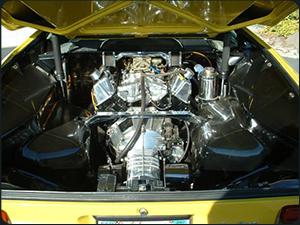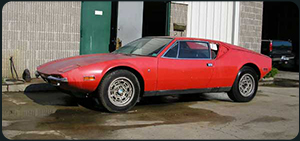1971-74 DeTomaso Pantera
The 1971-74 DeTomaso Pantera combined Italian exotic sports car styling
and a reliable, potent Ford V-8. The Pantera cost about half
as
much as an Italian exotic Ferrari or Maserati sports car. In fact, it
was the first affordable mid-engine exotic.
Seem to good to be true? Well, yes and no. But mostly yes.
The Pantera was the result of a collaboration between Ford Motor and
fiery, erratic, modestly successful sports car builder and former auto
racer Alejandro DeTomaso. He had moved to Italy from Argentina with his
wealthy American wife, Isabelle Haskell, who backed his business
ventures.
DeTomaso convinced top Ford Motor executive Lee Iacocca to have Ford
back and sell the Pantera in America, with DeTomaso handling
distribution elsewhere. The Ford-powered Cobra sports car was gone, and
Ford Motor wanted a sports car such as the Pantera to maintain its
high-performance image in the early 1970s.
Such a car also would be a sexy addition to Ford Motor's staid
Lincoln-Mercury division car line. And chairman Henry Ford II had
wanted a sexy Italian auto to go with his new Italian wife since Ford
Motor failed to buy the Ferrari auto company in 1963.
The Pantera was based on DeTomaso's sleek but notoriously unreliable
1967-71 low-volume Ford-engine Mangusta sports car, which should have
served as a warning to Iacocca that the Pantera might be troublesome.
With Ford's major support, the Pantera's final assembly was done at the
DeTomaso factory in Modena, Italy. Ford made sure the Pantera had
better detail engineering than the Mangusta and installed air
conditioning, which was unusual in an Italian exotic.
The Pantera had a gorgeous low-slung body from Italy's Ghia exotic car
styling outfit and a race-style mid-engine layout. It gave up little to
pricey Italian sports cars with its dramatic, wedge-shaped lines,
all-independent suspension, all-disc brakes, magnesium wheels and
five-speed ZF manual transmission.
The Pantera's 351-cubic-inch pushrod V-8 produced 310 horsepower,
letting the 3,100-pound car reach 70 mph in second gear and hit about
150 mph. The V-8 lacked the complicated overhead-camshaft V-12 engines
in Ferraris, but so what? A Ford pushrod V-8 in a Shelby Cobra sports
car beat Ferrari for the world manufacturer's championship in 1965 and
was much easier and cheaper to maintain.
The Pantera was flat-out sensational in the early 1970s. The only rival
U.S. sports car was the Chevrolet Corvette, which had over-the-top
styling and the same front-engine layout as the original1953 'Vette.
The Pantera was unveiled at the 1970 New York Auto Show and sent to
select Lincoln-Mercury dealers. It even had Ford Motor's normal
warranty. But quality of the first 300 or so cars suffered from
indifferent construction because they were rushed into production and
needed major fixes before being fit to sell. Arrival of the first ones
to dealerships thus was delayed for months.
The largely hand-built Pantera seemed too good to be true at
$10,295--about half the price of Italian exotic. The handsome black
leather interior was loaded with gauges, and attractive bucket seats
provided good support.
Never mind that faults included a tight interior, offbeat driving
position and indifferent construction. Wasn't that also the case with
"pure" exotic Italian sports cars?
However, complaints soon surfaced about engine overheating and
excessive cockpit heat. And most Lincoln-Mercury salespersons looked at
the car as if it were from Mars. They didn't have a clue about how to
sell such an exotic in showrooms alongside Mercury and Lincoln models.
While Pantera owners weren't gouged for service or parts, as were
Ferrari, Maserati or Lamborghini owners, Lincoln-Mercury mechanics soon
discovered that the Pantera was more complicated than they thought it
would be and found it frustrating to work on.
For example, no two Panteras seemed to have the same wiring layout, and
something always was going wrong with Pantera electrical systems.
Many Pantera owners were furious. They'd expected their car to be as
rock-sold-reliable as a Mercury or Lincoln, which were about as
conventional as they could get. Some bought the Pantera just because it
looked racy and was fast--and far less costly than a Ferrari, Maserati
or Lamborghini. Owners of those cars expected problems, but Pantera
owners weren't nearly as forgiving.
Ford Motor quickly got the message and for awhile had the special West
Coast shops of Ford racer Bill Stroppe do modifications to cure Pantera
problems.
By 1973, the car was much better, but had gotten a reputation for being
troublesome. Then the 1973-74 gas crisis further hurt sales of the
fuel-thirsty Pantera--along with sales of Italian exotic
sports
cars.
Curiously, the Pantera had been designed without regard for upcoming
U.S. safety and emissions standards. The emissions rules caused
horsepower of the Pantera's V-8 to fall to 250 by 1973. And
Ford
knew from the beginning that the Pantera wouldn't meet stricter federal
bumper standards after 1974. An ungainly looking black rubber nose
guard and larger rear bumpers were put on 1973 Panteras to meet 1973-74
requirements.
The 1975 bumper standards would have involved a major redesign of the
car, including a new powertrain. Ford Motor felt that would be too
costly--especially since the Pantera was a limited-volume auto to begin
with.
American imports of the Pantera thus were discontinued after 1974.
However, the car continued to be sold with Ford of Australia engines at
much reduced levels in Europe, where it was largely unchanged for
years.
Lincoln-Mercury said it sold 6,091 Panteras, but most sources said the
figure was 5,629 cars. In any case, many owners of surviving Panteras
fixed reliability problems long ago.
The Pantera still looks great and is plenty fast. Glancing back, it was
a steal, and a good one remains a bargain.
